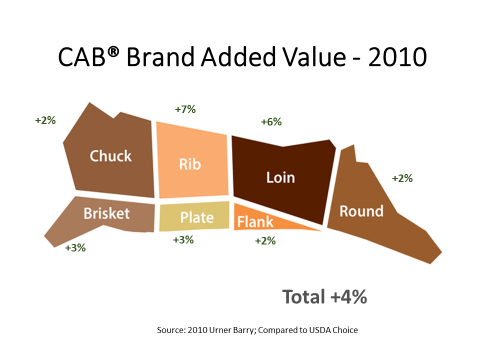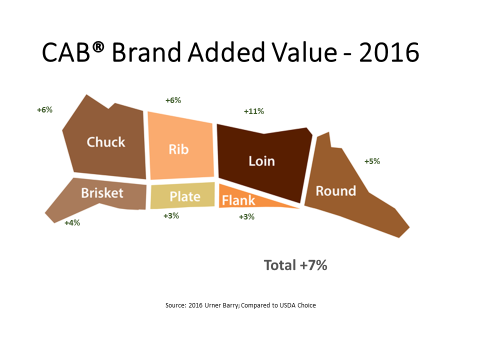
Building Premiums, cut by cut
by Miranda Reiman
Something doesn’t add up.
In 2016, U.S. packers saw Choice beef production increase by 8.1% while that of the Select grade held steady. Yet the value of Choice over Select (the Choice-Select spread) went up by $3.47 per hundredweight (/cwt.).
“If you’re just looking at supplies, you’d assume the premiums for hitting those higher quality endpoints would go down,” says Mark McCully, vice president of production for the Certified Angus Beef ® (CAB®)brand. “But that’s where the story of demand really shines.”
The Choice-Select example pales compared to the growing CAB premium. After 10 years of record volume sales leading to more than a billion pounds last year, the CAB-Choice spread was up $5.77/cwt. to average a record-wide $14.44/cwt. advantage last calendar year.
“Many think most of the brand’s value comes from steaks and the high-end, five-star steakhouses,” McCully says. “They’re an important part of our business, but we see end-meat users starting to add even more dollars back to the carcass.”
In 2010, Urner Barry market data showed a 7% CAB premium over Choice ribs and a 6% CAB value advantage over Choice loins. That’s compared to a 2% CAB premium over both the Choice chuck and round. By 2016, the CAB brand premiums for those middle-meat primals were 6% and 11% above Choice, respectively—but the end meats’ contribution nearly tripled. The CAB value advantage over Choice had grown to 6% for the chuck and 5% for the round.
Simply put, it’s not all about the steaks.
Overall, high beef prices led to more end-meat features at retail, and might have inspired consumers to change up their menus, says Gary Morrison, market reporter with Urner Barry.
“You go to the food store and you see a package of chicken sitting there and it’s $10. You can feed your family with that and the package of two steaks might be $40 or $50. What are you going to do?” the analyst asks. “People seemed to find these alternate cuts and the industry has done a good job promoting them. That’s driving the demand of end meats.”
It’s not simply a matter of trading down to less-expensive cuts, however. End meats grew in popularity largely because an increasing share of them were of premium quality and carried less risk of disappointment.

Mark Polzer, CAB vice president of business development, says the chicken industry may have figured it out first, but beef is taking full advantage now: adding value cut-by-cut improves profitability on the entire carcass.
“They took an item like chicken wings, which was a ‘giveaway’ item—and now it commands huge money because it’s featured on so many menus,” he explains.
Many beef marketers are finding similar opportunities with formerly “underutilized” cuts.
“They’re pulling the teres major and flat iron out of the chuck and they’ve created real value,” Polzer says, noting those can fetch double the price of a bone-in chuck roll. “So you’re pulling $4 to $5 items out of a $2.50 item. That helps the value of the chuck significantly.”
Higher beef quality grades nationwide have opened doors.
“The average inside round or chuck roll is going to be more highly marbled than it was 20 years ago,” Polzer says. “That doesn’t mean you’d cut a slab of inside round and put it on the grill and have it be the eating experience of a steak, but it is significantly better and lends itself to more uses.”
Morrison says when beef buyers are experimenting with new cuts, they will choose a brand or quality-level they trust.
“I think they know, ‘Hey, buy the quality, and you’re going to taste the difference,’” he says.
Maybe that helps explain that the tripling of the CAB value premium over Choice chucks since 2010.
“The good news is that this is additive,” McCully says. “It’s not that traditional cuts like a filet mignon or ribeye are bringing less—even they are commanding a higher premium—but the quality bonus on things like short ribs and briskets is increasing even faster.”

Dining trends, such as an increase in Tex-Mex fare and premium burgers, are supportive, Polzer says.
“Fifteen years ago, everybody thought of ground beef as a commodity item, but it’s been our fastest growing segment the last five years,” he says.
Export trade to countries like Japan adds up, too.
“One of their favorite items to merchandize is the chuck that they slice very thinly, and they also do a good job on the short plates and thin meats as well,” Polzer says.
Value-added processors, who often use end meats to create pre-cooked beef options for both retail and foodservice customers, find that starting with high-quality beef is one less variable they have to worry about, he says. Sales of CAB value-added products increased 8.9% last year.
“This continues to drive the message back to the producer: quality pays,” Polzer says.
Turns out the numbers add up, and the dollars do, too.
You may also like
$100,000 Up for Grabs with 2024 Colvin Scholarships
Certified Angus Beef is offering $100,000 in scholarships for agricultural college students through the 2024 Colvin Scholarship Fund. Aspiring students passionate about agriculture and innovation, who live in the U.S. or Canada, are encouraged to apply before the April 30 deadline. With the Colvin Scholarship Fund honoring Louis M. “Mick” Colvin’s legacy, Certified Angus Beef continues its commitment to cultivating future leaders in the beef industry.
Raised with Respect™ Cattle Care Campaign Launched This Fall
Raised with Respect™ was developed as part of a strategic cattle care partnership between Sysco and CAB. The collaboration focuses on supporting farmers and ranchers, equipping them with continuing education to stay current on best management practices and helping to increase consumer confidence in beef production.
Drought Impact and Cattle Industry Dynamics
As drought conditions persist across much of cattle country, farmers and ranchers are at a pivotal juncture in the cattle industry’s landscape. What impact does this prolonged dry spell have on the nation’s herd numbers? When will heifer retention begin? How will industry dynamics influence the spring bull sale season?



